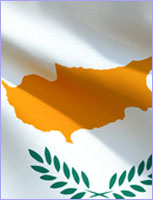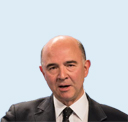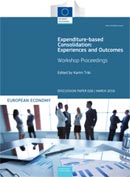|
|
|
|
|
|
|
|
|
|

|

|

|

|
Cyprus exits its financial assistance programme; macroeconomic imbalances remain to be tackled
On 31 March, the financial assistance programme for Cyprus formally concluded after three years. The programme was designed to achieve three main objectives: stabilise and reform the Cypriot financial sector, ensure sound fiscal consolidation, and implement reforms to support competitiveness and growth. Thanks to the efforts of the Cypriot authorities in implementing the necessary structural reforms, confidence has returned, growth is picking up, the banking system has further healed and the fiscal outlook has improved substantially. The European Commission is ready to support Cyprus in achieving sustainable economic growth. With the programme at an end, Cyprus has been reintegrated into the regular cycle of Economic Policy Coordination – the European Semester – and is subject to Post Programme Surveillance as foreseen by the Two-Pack Regulation. The Commission is closely monitoring the country’s macroeconomic imbalances, particularly a large private, public and external debt overhang amidst high unemployment, and is helping Cyprus to implement further structural and fiscal reforms.
|

|

|

|
|

|

|

|

|

|

|
|

|

|

|
|
With the conclusion of the programme, the country has moved beyond the crisis.
|

|
Pierre Moscovici, Commissioner for Economic and Financial Affairs, Taxation and Customs
|
|
|
|

|

|

|

|
Investment Plan: EUR 150 million deal to support innovative companies in Finland and the Baltic countries; EUR 250 million in France
The European Investment Fund (EIF) and Pohjola Bank (part of the OP Financial Group), have signed a guarantee agreement to increase lending to innovative small and medium-sized enterprises (SMEs) and small mid-caps in Finland, Lithuania, Estonia and Latvia. This transaction agreed on 30 March benefits from the support of the European Fund for Strategic Investments (EFSI), the heart of the Investment Plan for Europe. The new agreement will allow Pohjola Bank and its 180 cooperative banks to provide EUR 150 million in loans to innovative companies in Finland and the Baltic states over the next two years, supported by an EIF guarantee under the “EU InnovFin finance for Innovators” initiative. Meanwhile, in France the EIF and Société Générale signed a COSME agreement that will allow the latter’s Franfinance subsidiary to provide EUR 250 million to support over 14,000 small enterprises.
|

|
|

|

|
|

|

|

|

|
Commission presents action plan to modernise VAT in the EU
On 7 April the European Commission presented an action plan on how it intends to make the EU Value Added Tax (VAT) system simpler, more fraud-proof and business-friendly. The current VAT rules urgently need to be updated so they can better support the Single Market, facilitate cross-border trade and keep pace with today’s digital and mobile economy. The ‘VAT gap’, which is the difference between the expected VAT revenue and VAT actually collected in Member States, was almost EUR 170 billion in 2013. Cross-border fraud itself is estimated to be responsible for a VAT revenue loss of around EUR 50 billion a year in the EU. At the same time, the current VAT system remains fragmented and creates significant administrative burdens, especially for SMEs and online companies. The action plan sets out a pathway to modernise the current EU VAT rules. This includes principles for a single European VAT system; measures to tackle VAT fraud; an update of the framework for VAT rates to give Member States greater flexibility in setting them; and simplified VAT rules for e-commerce and to make life easier for SMEs.
|

|
|

|

|
|

|

|

|

|
“Real Economy” episode explores role of microfinance in strengthening the economy and society
The latest episode of “Real Economy” examines how microfinance helps individuals and small businesses gain access to credit, and how that strengthens both the economy and society. In 2013, EUR 1.5 billion was disbursed via microfinance, with the average loan size at about EUR 8,500. Micro-enterprises represent over 90% of European enterprises and play a decisive role in boosting jobs, growth and investment, yet many have difficulty gaining access to finance. In Romania, for example, a maker of cellos was able to obtain a microcredit based on the sales and income his early stage business currently generated, whereas traditional banks demanded more proof that a loan could be reimbursed. Microfinance is not just about credit, however. Some Microfinance Institutes also offer their clients training throughout their project. Pier Luigi Gilibert, CEO of the European Investment Fund, describes microfinance as “a tool which can address a relatively large number of issues”, not only assisting the unemployed, but also empowering women and perhaps migrants. Crowdfunding and crowdlending, in which individuals and businesses lend directly to borrowers, are also changing the game in microfinance. A new episode of “Real Economy” airs every two weeks at 10.45 am CET and is repeated 12 times throughout the week. “Real Economy” can also be viewed online.
|

|
|

|

|
|

|

|

|

|
Euro area annual inflation up to -0.1%
Euro area annual inflation is expected to be -0.1% in March 2016, up from -0.2% in February, according to a flash estimate published on 31 March by Eurostat, the statistical office of the EU. Looking at the main components of euro area inflation, services is expected to have the highest annual rate in March (1.3%, compared with 0.9% in February), followed by food, alcohol & tobacco (0.7%, compared with 0.6% in February), non-energy industrial goods (0.5% compared with 0.7% in February) and energy (-8.7%, compared with -8.1% in February).
|

|
|

|

|
|

|

|
 |

|
February 2016 euro area unemployment rate down to 10.3%, EU at 8.9%
The euro area seasonally-adjusted unemployment rate was 10.3% in February 2016, down from 10.4% in January 2016, and from 11.2% in February 2015. This is the lowest rate recorded in the euro area since August 2011. The EU unemployment rate was 8.9% in February 2016, stable compared to January 2016, and down from 9.7% in February 2015. This is the lowest rate recorded in the EU since May 2009. The figures were published on 4 April by Eurostat, the EU statistical office. Eurostat estimates that 21.7 million men and women in the EU, of whom 16.6 million were in the euro area, were unemployed in February 2016. Compared with January 2016, the number of unemployed persons decreased by 59,000 in the EU and by 39,000 in the euro area. Compared with February 2015, unemployment fell by 1.97 million in the EU and by 1.3 million in the euro area.
|

|
|

|

|
|

|

|
 |

|
EU's top trading partners in 2015: the United States for exports, China for imports
According to data published on 31 March by Eurostat, the EU statistical office, the EU’s top trading partners remain the same, although trends for each are very different. In 2015, the United States (EUR 619 billion, or 18% of total EU trade in goods) and China (EUR 521 billion, or 15%) continued to be the EU’s two main goods trading partners, well ahead of Switzerland (EUR 253 billion, or 7%) and Russia (EUR 210 billion, or 6%). After recording a significant and almost continuous fall until 2011, the share of the US in the EU’s total trade in goods has begun to increase again, and reached 18% in 2015. Meanwhile, the share of China has doubled since 2002, rising from 7% to 15% in 2015. In contrast, since 2013 the share of Russia in the EU’s total trade in goods has declined sharply to 6% in 2015, while the share of Switzerland has remained almost unchanged at 7% over the entire time period. In 2015, machinery and transport equipment, other manufactured goods and chemicals represented the main product categories in EU international trade with the rest of the world.
|

|
|

|
|
|
|
|
|
|

|

|

|

|
Expenditure-based consolidation: Experiences and outcomes – workshop proceedings. European Economy. Discussion Papers 26.
This paper examines the proper design of fiscal adjustment as an essential aspect of a successful approach to consolidation. It is the record of the proceedings from a workshop held by DG ECFIN on 20 January 2015, and includes an introductory address by ECFIN Director-General Marco Buti. Participants in the workshop discussed theoretical and policy issues associated with expenditure-based consolidation during three sessions: Session 1: "Expenditure-based consolidation or tax based consolidation: evidence from a cross-country perspective"; session 2: "Interaction between private and public sector in difficult times: impact of uncertain economic environments on consolidations"; and session 3 "Structural and institutional reforms in the context of an expenditure-based consolidation".
|

|
|

|
|
|
|
|
|

|

|
Euro Area employment Trends
|

|

|

|

|

|

|
|
|
|
|
|
|
|
|
|
|
|
|
|
|
|
|
|

|
|
Directorate-General for Economic and Financial Affairs
|

|
|